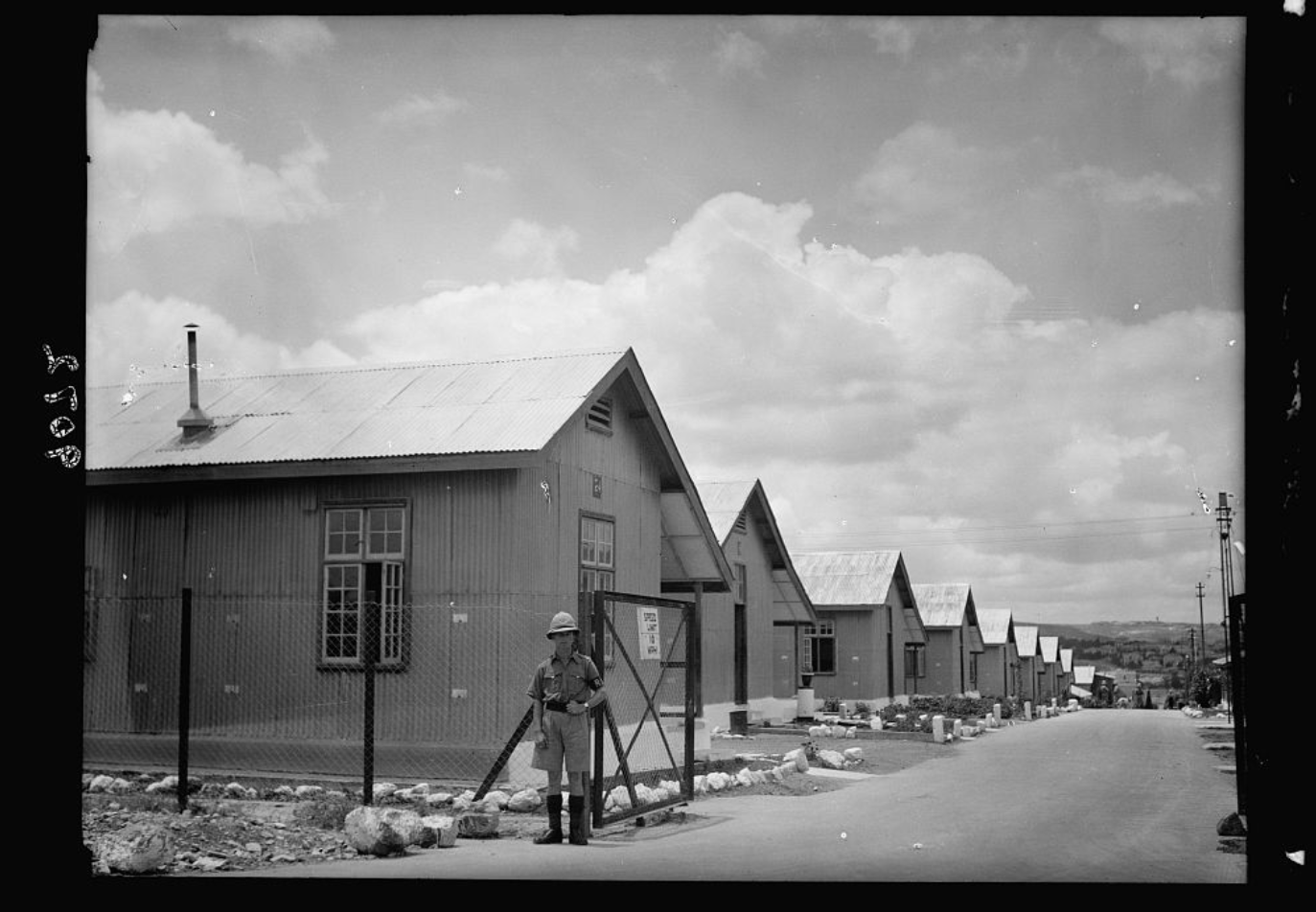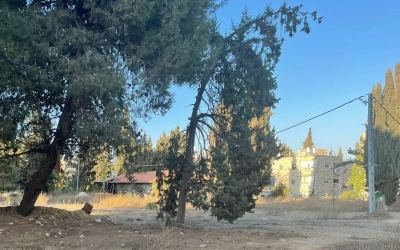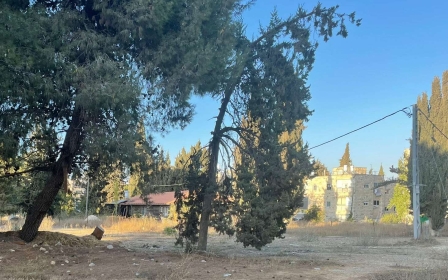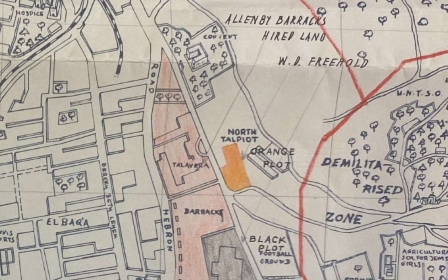UK traded Jaffa 'sand dunes' with Zionists for Jerusalem embassy land

The British government acquired a plot in Jerusalem long earmarked for a future embassy in Israel by trading an area of sand dunes in Jaffa with a company acquiring Palestinian land for Jewish immigrants, newly unearthed documents show.
In October, a Middle East Eye investigation revealed that the UK government holds a 6,950 square-metre property in West Jerusalem's Talpiot neighbourhood known as the "Orange Plot".
Documents found by MEE in the UK's National Archives show that as early as the 1950s, British officials were discussing potential locations for an embassy on UK-held land in Jerusalem, and considered it inevitable that a site would one day be needed.
'I cannot help feeling that the military authorities are in some cases persuading the District Commissioner to abuse the powers conferred under Defence Regulation 4(2)'
– British Mandate official, 1939
Now, records recently found in the Israeli State Archives by Adalah, the Haifa-based advocacy group, show how the Jerusalem property came into British possession in April 1933, a decade into British rule over Palestine under the mandate conferred by the League of Nations after World War One.
Letters exchanged between Mandate officials show that the Palestinian Government, as the British administration was called, exchanged land described as sand dunes in the Jabalia area of Jaffa for a Jerusalem plot which had been purchased by the Palestine Land Development Company (PLDC).
New MEE newsletter: Jerusalem Dispatch
Sign up to get the latest insights and analysis on Israel-Palestine, alongside Turkey Unpacked and other MEE newsletters
The PLDC had been established in 1908 by the World Zionist Organization - and incorporated in the UK - to acquire land in Palestine for Jewish immigrants. The letters explain that it had bought the land in Jerusalem in 1921 "at 13 Egyptian Piastres a pic [Ottoman-era units of currency and measurement]" but do not say from whom.
"I have discussed this matter with the Palestinian [sic] Land Development Company Ltd, and have agreed, subject to your concurrence, the Government should transfer to the Company the three parcels of Government land in the Jabalia sand dunes," wrote JN Stubbs, director of lands, to the administration's chief secretary in March 1933.
The government's land in Jabalia was, at 105 metric dunams (105,000 square metres), 12.5 times the size of the Jerusalem plot that the company was prepared to exchange, Stubbs noted.
"But I would observe that I propose to acquire all of the level land instead of a proportion of level and sloping land. Any value assignable to the sand dune must be dependent solely on the activities of the Company in the neighbouring area," Stubbs said.
How the PLDC used the Jabalia land is not yet known to MEE, but a letter in the file suggests it was slated for future development.
In 1932, the acting district commissioner responsible for the Southern District wrote that the property was undeveloped and valued at 10 Palestinian pounds (LP) per dunam, adding: "As soon as development begins in that area, the price will rise and may reach LP 70 - LP 120 per dunam in a short time."
The area then known as Jabalia is now in the southern suburbs of Tel Aviv-Yafo, about three kilometres south of the old port of Jaffa.
Documents in the same file suggest the Jerusalem plot - known even then as the "Orange Plot" - was earmarked to house married British officers at what was then called the Talavera Camp.
The file offers glimpses into a years-long process by which the British acquired dozens of plots that would eventually transform Talavera Camp into the permanent Allenby Barracks, named after General Edmund Allenby, who led the British campaign in Palestine against the Ottoman Empire during World War One.
The file, along with other documents from the same time period seen by MEE, paints a picture of an administration struggling to balance the increasing need for permanent barracks in the face of growing opposition to British rule - which culminated in an uprising known as the Great Arab Revolt in 1936 - with the knowledge that it would one day withdraw from Palestine and cede power to others.
Tensions with London
Documents reveal that as the years passed, there were tensions between the Mandate government in Jerusalem and the War Department in London over who would pay for properties, and whether there were grounds to continue holding others that had been expropriated under imposed British laws.
One plot that raised concerns was owned by Andoni and Ishac Halabi and taken over by the army in 1936 under emergency regulations, according to a letter sent from a Mandate official in the office of the Commissioner of Lands and Surveys to the administration's chief secretary.
In the 1939 letter, the official says he is concerned that a rental agreement struck between the Halabis and the administration's district commissioner in 1937, after the property was expropriated, significantly undervalued it.
"I cannot help feeling that the military authorities are in some cases persuading the District Commissioner to abuse the powers conferred under Defence Regulation 4(2) ," the official wrote.
At the time of writing, the Halabis had applied for the parcellation of their land, seemingly as a first step to developing it. The army, the official notes, would not allow for that - but could also not tell the Halabis if and when their land would be purchased by the British.
"This Defence Regulation was surely only introduced to enable land required in emergency for a short period to be taken possession of urgently and for the necessary compensation to be quickly assessed without the unavoidable delays," he wrote.
"The fact that this land is likely to be occupied for a considerable period and appears to be an adjunct to the Allenby Barracks, the site of which has been in the occupation of the Army for many years, inclines me to think that the application of Defence Regulation 4(2) in this case is difficult to justify."
The acquisition of the "Orange Plot", however, seems to have been more straightforward. It was "acquired by [the Palestinian] Government at a time when the latter was meeting all capital expenditure in respect of the Defence forces in Palestine," the government's chief secretary wrote in 1939.
Another key property - labelled as the "Black Plot" - was also acquired by the Palestinian Government in this way, he noted.
That property, which housed quarters for married British soldiers, is the same plot where the US has proposed to build a new embassy and diplomatic compound despite the objections of the heirs of the original Palestinian landowners whose properties were confiscated by Israel in 1950.
The Mandate government officially gave both properties to the War Department in November 1942 "unconditionally and free of charge", according to a 1947 memo held in the UK's National Archives.
However, when the sites were sold, the proceeds from the sale were to be "credited to the Palestine Government".
But in the case of the "Orange Plot", that eventuality has never come to pass.
In 1965, the UK government sold the majority of the remaining Allenby Barracks land - including the "Black Plot" - to the Israeli government for £140,000, but held onto the “Orange Plot”, which was leased to Israel for £1 annually, for 40 years.
In 2007, the lease was renewed for 40 years with Israeli land records seen by MEE identifying the owner of the land as the “Secretary of state for Foreign and Commonwealth affairs of Great Britain and Northern Ireland”.
Middle East Eye delivers independent and unrivalled coverage and analysis of the Middle East, North Africa and beyond. To learn more about republishing this content and the associated fees, please fill out this form. More about MEE can be found here.






